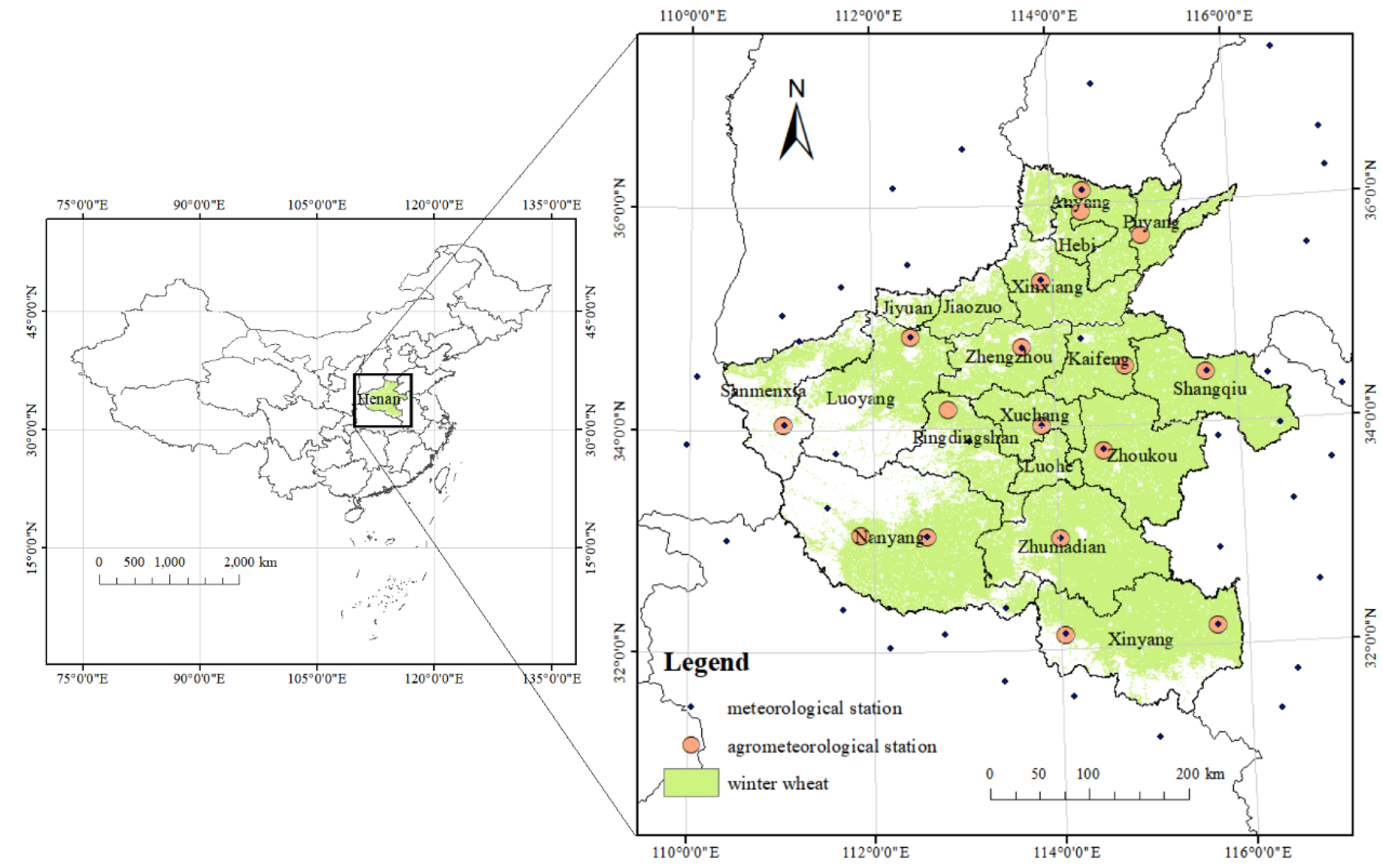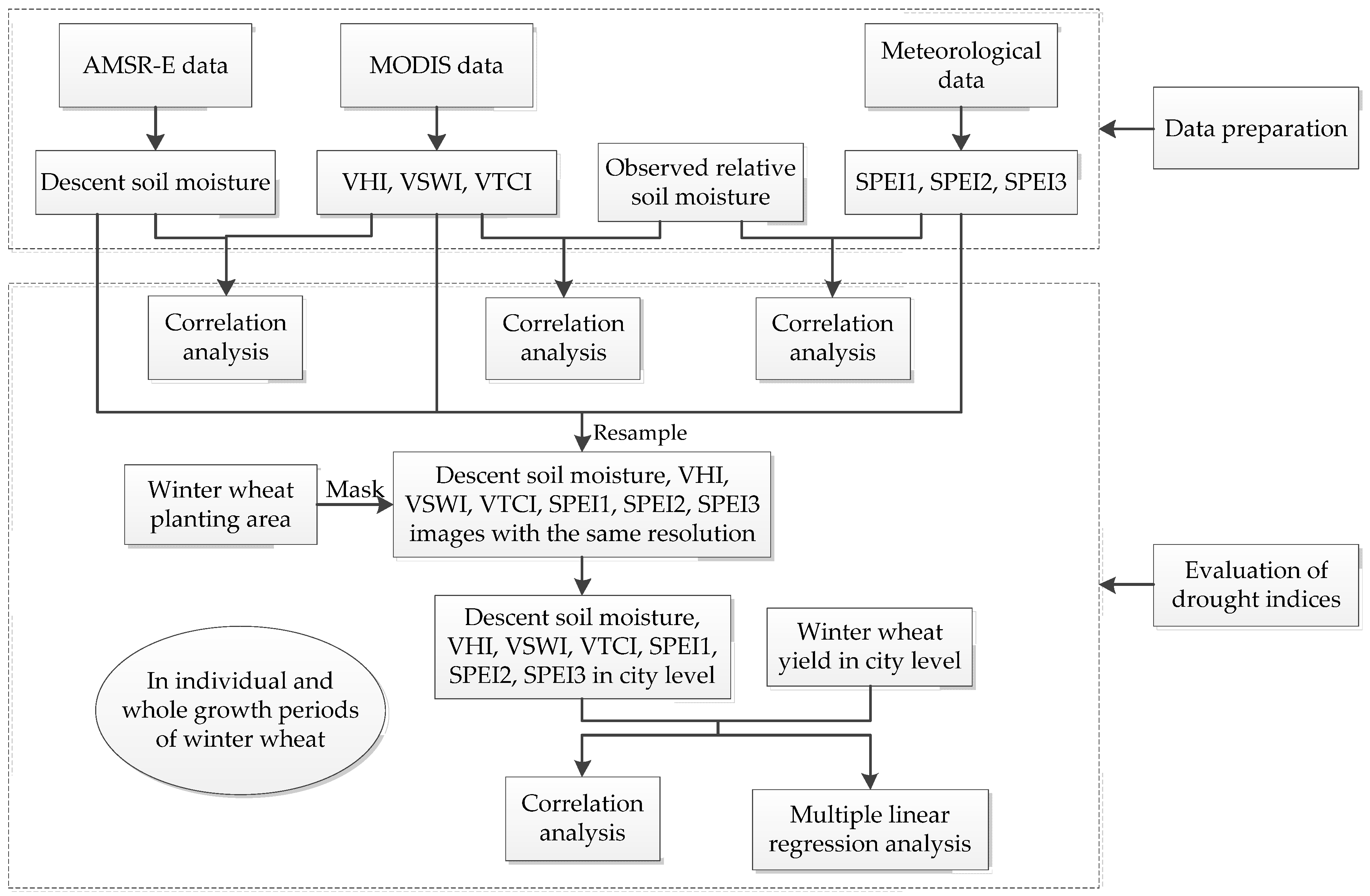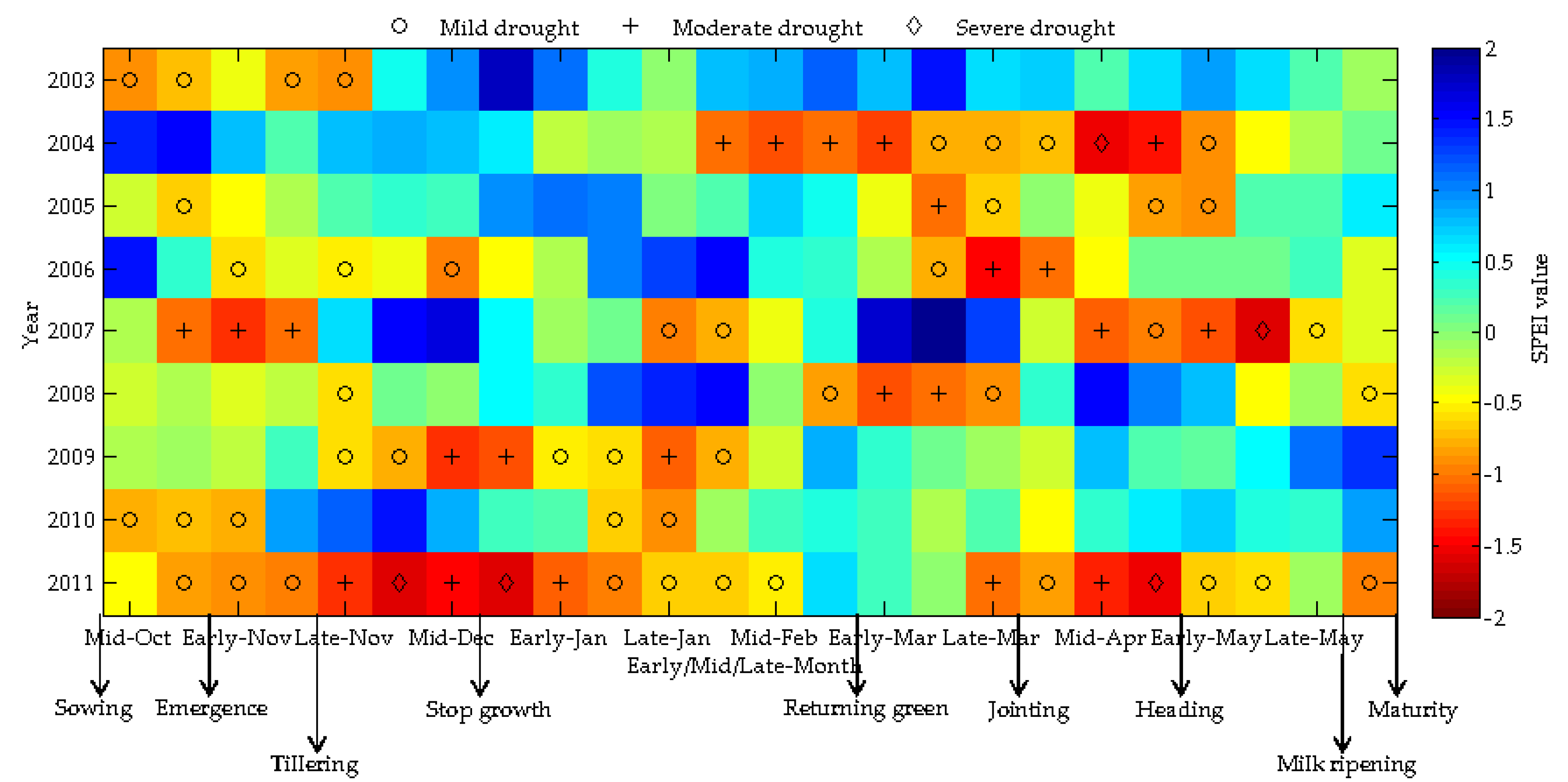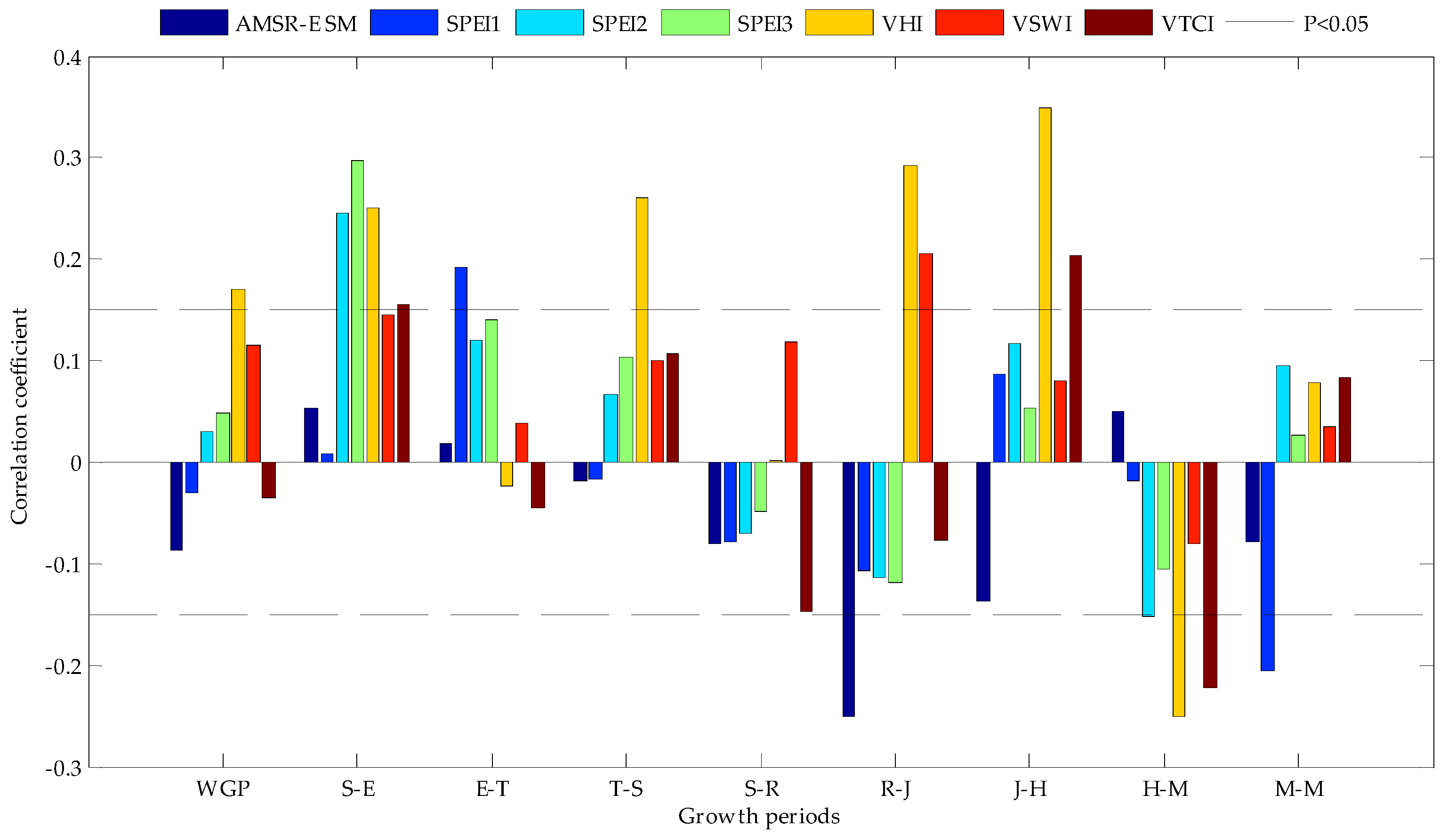1. Introduction
Drought is a ubiquitous climate phenomenon that has brought serious challenges to ecosystems and human society from ancient to modern times [
1]. Drought can lead to large-scale crop yield reduction or even crop failure, posing a serious threat to national food security and sustainable agricultural development [
2,
3]. There is increasing drought globally because of global warming [
4,
5]. Due to the decrease in precipitation, there is an arid trend in many areas of China [
6]. Drought not only destroys people’s living environment, but also disrupts agricultural production [
7]. Therefore, it is important to study the characteristics and causes of drought, especially agricultural drought.
Drought can be divided into meteorological, agricultural, hydrological, and socioeconomic drought in terms of object and impact form [
5]. The different types of drought are closely linked. A lack of precipitation and high evapotranspiration cause meteorological drought. The reduction of soil moisture results in agricultural drought. Low discharge and groundwater lead to hydrological drought in the long term. Finally society, economy, and the environment are affected, leading to socioeconomic drought [
8]. Due to the complexity of the causes of agricultural drought, many factors need to be considered, such as vegetation types, soil properties, crop growth, weather conditions, and so on. According to the National Agricultural Drought Standard of China Meteorological Administration, the crop water deficit anomaly index, relative soil moisture, and indicators of farmland and crop drought morphology are used to classify the grade of agricultural drought [
9]. Traditional drought monitoring is site-based, which is time-consuming and expensive. With the development of remote sensing technology, large-scale and long-time series of drought monitoring have been realized.
In recent years, remote sensing has played a more important role in drought research. With the development of different types of optical and microwave products, the accuracy of drought monitoring has improved. Many scholars at home and abroad have proposed a variety of agricultural drought remote sensing monitoring indices by combining different spectral bands, which can provide more information than a single spectral band [
10]. Optical drought indices were widely used, but the image of the optical band was susceptible to atmospheric influence, resulting in poor quality and discontinuity of products in time and space. Microwave has strong penetration and can monitor the land surface all day [
11]. It is highly sensitive to soil moisture, resulting in a wide range of applications in soil moisture estimation. Passive microwave data have the characteristics of high temporal resolution and low spatial resolution. It is more appropriate to use passive microwave data to retrieve soil moisture than active microwave data, because of the more direct relationship between soil dielectric constant and soil moisture. Moreover, passive microwave data can estimate soil moisture over a wide range [
12]. At present, the main passive microwave remote sensing data are the Scanning Multichannel Microwave Radiometer (SMMR), Special Sensor Microwave (SSM), and Advanced Microwave Scanning Radiometer for EOS (AMSR-E). The first two sensors have low spatial resolution and focus on oceans and atmosphere, and are not ideal for land monitoring, while AMSR-E can provide soil moisture change data at the global scale with developing resolution [
13]. Some studies have shown the diverse performance of the AMSR-E products in different regions, and the most encouraging results were found in semi-arid regions [
14].
The development of agricultural drought monitoring indices is from meteorological to remote sensing indices in the 20th century, and the integrated indices received attention in the past 10 years [
5]. Combining different types of data, such as soil, meteorology, phenology, optical remote sensing, microwave remote sensing, etc., to build a multi-source monitoring index has become a hot spot in drought monitoring research. By doing that, we can monitor various types of drought and obtain more comprehensive and accurate monitoring information [
15]. Many studies have compared the differences and effects of drought monitoring based on different indices and explored the correlation between the different indices. For example, Chen et al. [
16] compared the temporal and spatial changes of drought in Henan Province based on the standard precipitation evapotranspiration index (SPEI) and temperature vegetation dryness index (TVDI). Chen [
17] combined the drought monitoring effects of the standard precipitation index (SPI) and vegetation temperature condition index (VTCI), and the results proved that the dynamic consistency between VTCI and 1-month SPI (SPI1) was improved. Wang et al. [
18] used SPEI and normalized difference vegetation index (NDVI) to study the effects of meteorological drought on vegetation at the catchment scale in China, and explored the correlation between SPEI and NDVI.
Besides comparing various types of drought, studying the combinations of different drought indices to obtain a comprehensive index is popular. The multivariate joint distribution, principal component analysis (PCA), information mining, and linear combination methods are used to obtain comprehensive drought indices. The multivariate joint distribution method generally uses the copula function to construct a joint distribution function of drought-related factors such as precipitation, soil moisture, and runoff or corresponding drought indices [
19]. PCA is used to transform sets of possible correlation variables into independent variables through orthogonal transformation, to reduce the dimension and make a few independent principal components reflect the information of most variables [
20,
21]. In the context of big data, the information mining method is used to mine the relationship between drought factors and drought, which include vegetation index, precipitation data, elevation, slope, and aspect, relying on a large number of samples through machine learning methods such as classification regression tree [
22], artificial neural network [
23,
24], and random forest [
25]. Although the above methods provide new ideas for multivariable monitoring, the multi-source drought index based on the linear combination method has been widely used because of its simple operation. This method usually assigns different weights to different sources of data, and a comprehensive drought index is then obtained by linear combination. Rhee proposed the scaled drought condition index (SDCI), which combines land surface temperature (LST) data, NDVI data from the Moderate-Resolution Imaging Spectroradiometer (MODIS), and precipitation data from the Tropical Rainfall Measuring Mission (TRMM) by the empirical weights method [
26]. Zuo et al. obtained the combined deficit index (CDI) by giving different weights to precipitation anomalies and NDVI anomalies, and evaluated the CDI of farmland and dry land using SPI and SPEI to obtain the optimal weight [
27]. Sun et al. [
28] and Zhang et al. [
29] conducted a multivariate linear analysis between remote sensing and meteorological drought indices, and the results showed that the composite index was more stable and adaptable to different topography than a single index. The constrained optimization method is superior to PCA in optimizing the parameters of the variables when combining them by maximizing the correlations with the in situ indices, which is essentially linear regression [
30].
Henan Province is located in Central China, which is not only the country’s major agricultural province but also the main winter wheat producing area. According to the Henan Statistical Yearbook, the wheat planting area in China in 2017 was 24.508 million hectares, and 5.715 million hectares (23.3%) were in Henan Province. The output of wheat in China in 2017 was 134.334 million tons, and 37.052 million tons (27.6%) came from Henan Province. Henan is located in the transition zone from subtropical to warm temperate zone, with complex terrain. Drought occurs frequently in the province, especially in spring and early summer, which poses a serious threat to the yield of winter wheat [
31]. Therefore, it is important to monitor the drought in a timely and effective manner and estimate the winter wheat yield accurately in Henan Province [
7].
Many studies have analyzed the effects of drought on yield in different growth periods of winter wheat. Wang et al. analyzed the relationship between soil moisture at 0–50 cm and the yield of winter wheat during the growth period in different months, and showed a better relationship in October and November of the year before harvest than other months [
2]. Huang et al. compared the relationship between vegetation health index (VHI), drought severity index (DSI), temperature vegetation dryness index (TVDI), and yield in different growth periods of winter wheat, showing that drought that occurred in the jointing and grain-filling stages had a great influence on yield [
32]. The above studies were based on comparisons between a single drought index or soil moisture and yield in different growth stages of crops, and there has been less research on the comprehensive drought index related to the growth period of crops. Therefore, in this study, multi-source data (meteorological, optical remote sensing, and passive microwave data) were used to retrieve the drought indices of winter wheat in Henan Province. The monitoring results of drought indices of different sources in individual and whole growth periods were analyzed. A multi-source linear regression relationship was then established to estimate the yield by using the drought indices as the independent variables. This study aimed to explore the performance of different types of drought indices, conduct multiple regression of the indices in individual and whole growth periods, and provide a reference for regional winter wheat drought monitoring.
5. Discussion
The correlations between LST and EVI (
Table 9) and between LST, EVI, and 10 cm soil moisture (
Table 10) were analyzed. In the whole growth period, the correlation between EVI and LST is significantly positive (R = 0.248). In individual growth periods, the correlation between EVI and LST is significantly positive from emergence to jointing stages. There should be a significant negative correlation between EVI and LST. However, for long-term research, the negative relationship may change. It has a strong negative correlation in the warm season, but a positive correlation in the winter [
41]. The early growth period of winter wheat is winter, resulting in positive correlation coefficients in these periods, and the negative correlation between EVI and RSM10 (
Table 10). Compared with
Table 5, correlations between EVI, LST, and RSM10 are higher than VHI and VTCI in the whole growth period. However, in individual growth periods, the performance of LST and EVI is not as good as VTCI. Therefore, the combination of LST and EVI is effective in drought monitoring, especially in individual growth periods.
The SPEI image plays an important role, because of the small difference in precision between interpolating and interpolated stations, and as one of the optimal variables in multiple linear regression of yield estimation. The drawback of SPEI images is that they were interpolated from sparse sites, so the accuracy cannot be guaranteed at a large scale. It would be beneficial to focus on obtaining regional meteorological index images with high precision for effective agricultural drought monitoring.
It can be concluded from
Table 8 that the effect of estimating winter wheat yield in a city using multivariate linear regression was obviously better compared to a single index. In the whole growth period, the coefficient of determination (R
2) can reach 0.282 using multiple linear regression of SPEI1, SPEI2, and VHI. However, VHI has the highest correlation with yield (R = 0.170) with R
2 = 0.029 in single index. Moreover, in individual growth periods, R
2 increased more significantly using multiple linear regression than single data. The combination is usually made up of the SPEI and MODIS drought indices. The indices in this study are all 10 days, which can monitor drought conditions on a small scale and monitor the drought more accurately than monthly data. Multiple linear regression was conducted using yield as the dependent variable directly, making the agricultural drought monitoring more meaningful.
The overall accuracy needs to be improved in this study. When the study area is large, applying different models based on different regions would improve the accuracy. In addition, the accuracy would also improve with the model based on relative drought years and normal years [
27,
56]. Many factors should be taken into account in the estimation of yield, such as soil types, crop varieties, and pests, but we only considered drought conditions, reducing the accuracy of yield evaluation. The drought impact would be more significant in rain-fed areas than in irrigated areas [
32]. There are many irrigation districts in Northern Henan, leading to the low accuracy. Although the result of the AMSR-E data showed low accuracy in this study, there are many applications in multi-source drought monitoring using such data [
56].
Adding meteorological index products to multi-source index drought monitoring and crop assessment would be highly beneficial. Dividing the model more precisely based on different regions or phenological periods would improve the precision. In future studies, using different models in different regions on a large scale and combining crop models to divide the growth period more accurately will make agricultural drought monitoring and yield estimation more accurate. Moreover, incorporating remote sensing data into the process-oriented and machine-based crop models is an effective method to improve agricultural drought monitoring and yield estimation [
57,
58].
6. Conclusions
In this study, the drought monitoring effects of different indices from meteorological, optical remote sensing, and passive microwave data were compared. Multiple linear regression was used in the estimation of winter wheat yield based on different indices. The study was conducted in Henan Province in individual and whole growth periods with 10-day data.
When the drought indices were compared, MODIS and SPEI had a higher relationship with 10 cm soil moisture. In the MODIS drought indices, VSWI had the highest absolute correlation with 10 cm relative soil moisture (R = −0.206) in the whole growth period, while VTCI performed better in individual growth periods. For SPEIs, 10 cm relative soil moisture can be reflected by SPEI2 (20-day) and SPEI3 (30-day), but soil moisture of deeper layers needs an SPEI with a longer time scale to reflect changes, which indicates a lag between meteorological and agricultural drought. The correlation between AMSR-E SM and VTCI was the highest and stable during individual and whole growth periods.
When estimating winter wheat yield, using multiple linear regression of drought indices is better than single drought indices. In single drought indices, VHI shows a higher correlation than others in individual and whole growth periods. There was a positive correlation in the sowing–emergence, tillering–stopping growth, and jointing–heading stages, but a negative correlation in the heading–milk stage. VHI performed best, showing the highest correlation coefficient in the jointing–heading stage (R = 0.349, p < 0.01). In multiple linear regression of the drought indices, the combinations of SPEIs at two scales and one MODIS drought index or SPEIs at three scales were effective. The regression effect of the whole growth period is the best (R2 = 0.282). In individual growth periods, correlations in the late growth period were higher, especially in the returning green–jointing stage (R2 = 0.212). When using multiple regression drought indices to evaluate yield, drought in the whole growth period should be the main consideration, and drought in the jointing period should be supplementary.
In the future, studies based on precise modeling in different areas and on combinations of crop models to precisely divide the crop growth period will make drought monitoring and yield evaluation more accurate.











